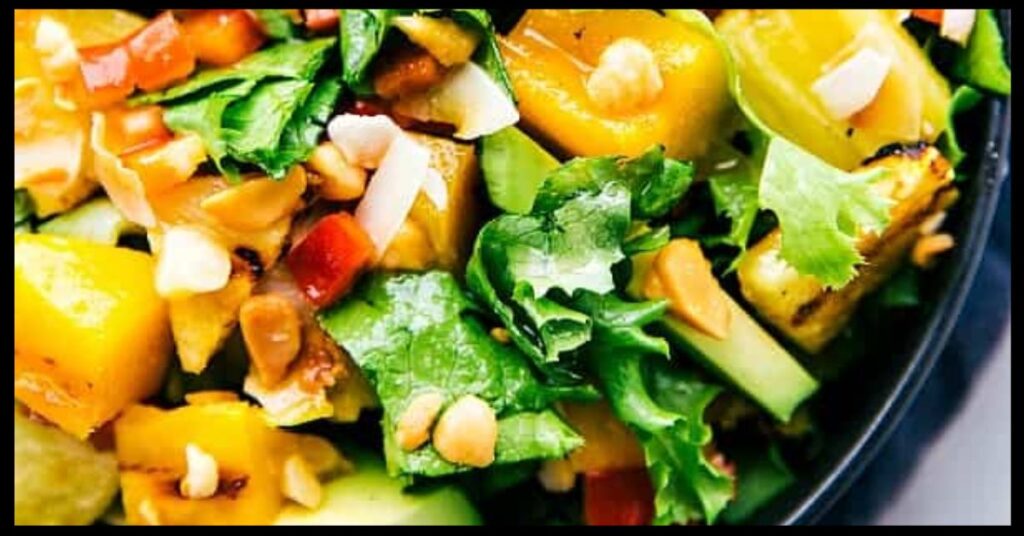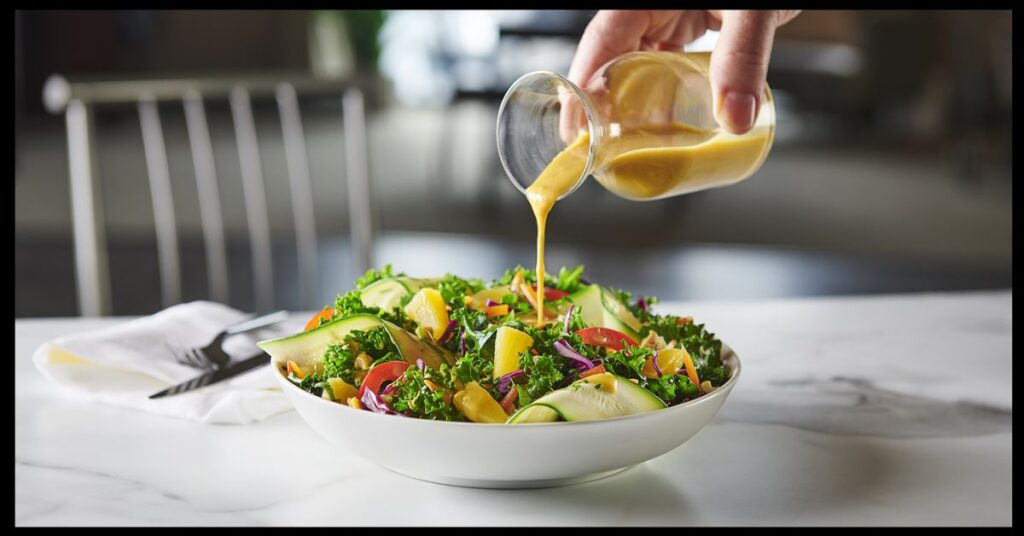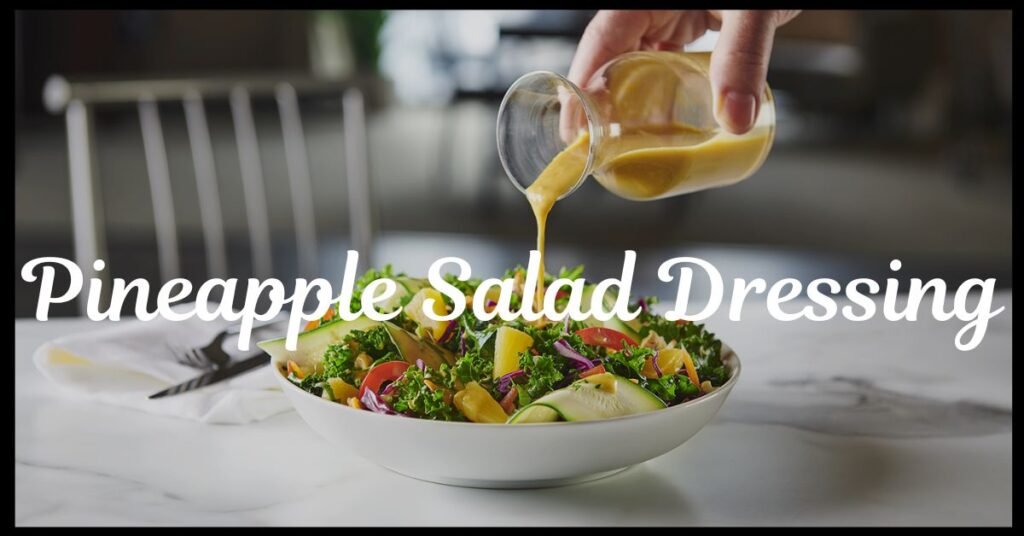Pineapple salad dressing is a flavorful and refreshing addition to any salad, combining the tropical sweetness of pineapple with savory, tangy ingredients. Ideal for fruit-based, green, or grilled chicken salads, this dressing offers a unique blend of flavors that can elevate simple dishes into vibrant culinary experiences. This article explores everything about pineapple salad dressing—from ingredients and health benefits to variations and usage tips.
Table of Contents
ToggleWhat is Pineapple Salad Dressing?
Pineapple salad dressing is typically made from fresh or canned pineapple, blended with a combination of oil, vinegar or citrus juice, herbs, and spices. The dressing is known for its sweet, tangy, and slightly acidic profile, which complements a wide range of salads.
Common Ingredients:
- Fresh pineapple or pineapple juice
- Olive oil or avocado oil
- Apple cider vinegar or lime juice
- Honey or maple syrup (optional)
- Dijon mustard or garlic (for depth)
- Salt and pepper
These ingredients work together to balance sweetness with acidity and savory elements, making the dressing versatile and widely appealing.

Health Benefits of Pineapple Salad Dressing
Using pineapple as a base for salad dressing offers several nutritional advantages:
1. Rich in Vitamin C
Pineapple is an excellent source of vitamin C, an essential nutrient that supports immune function, skin health, and iron absorption. One cup of fresh pineapple chunks provides over 88% of the daily recommended intake of vitamin C (USDA FoodData Central).
2. Anti-Inflammatory Properties
Pineapple contains bromelain, a group of enzymes that may reduce inflammation and aid digestion. According to a 2012 study published in Biomedical Reports, bromelain exhibits anti-inflammatory and immunomodulatory effects.
3. Low in Calories
When made without heavy oils or sugars, pineapple salad dressing can be a low-calorie option. Fresh pineapple juice contains about 130 calories per cup, making it a healthy base when used in moderation.
4. Natural Sweetness
The natural sugars in pineapple reduce the need for added sugars in the dressing, making it a healthier alternative to store-bought options with high fructose corn syrup or refined sugars.

How to Make Pineapple Salad Dressing at Home
Making pineapple salad dressing at home is simple and requires only a few ingredients and a blender or whisk.
Basic Pineapple Salad Dressing Recipe
Ingredients:
- 1 cup fresh pineapple chunks or 3/4 cup pineapple juice
- 1/4 cup olive oil
- 2 tablespoons apple cider vinegar or lime juice
- 1 teaspoon Dijon mustard
- 1 tablespoon honey (optional)
- Salt and pepper to taste
Instructions:
- Blend the pineapple, vinegar/lime juice, mustard, and honey until smooth.
- Slowly add olive oil while blending to emulsify.
- Season with salt and pepper to taste.
- Store in a sealed jar in the refrigerator for up to one week.
This homemade version contains no preservatives and allows customization to suit dietary needs or flavor preferences.
Variations of Pineapple Salad Dressing
Pineapple salad dressing is highly adaptable. Here are some creative variations:
1. Spicy Pineapple Dressing
Add a chopped jalapeño or a pinch of red pepper flakes to give the dressing a spicy kick. Ideal for grilled chicken or shrimp salads.
2. Creamy Pineapple Yogurt Dressing
Blend in 2 tablespoons of Greek yogurt or mayonnaise for a creamier texture. This version works well with coleslaw or tropical fruit salads.
3. Cilantro Pineapple Dressing
Incorporate a handful of fresh cilantro and a clove of garlic for a zesty, herb-infused dressing perfect for taco salads or bowls.
4. Ginger Pineapple Dressing
Grate fresh ginger into the mixture to add warmth and a slight zing. This Asian-inspired twist pairs well with cabbage or soba noodle salads.
Best Salad Pairings
Pineapple salad dressing complements a wide variety of salads. Here are some popular options:
1. Tropical Fruit Salad
Pair with mango, papaya, kiwi, and shredded coconut for a refreshing and colorful dish.
2. Grilled Chicken Salad
Combine mixed greens, grilled chicken, avocado, and red onion with the dressing for a balanced, protein-rich meal.
3. Shrimp and Quinoa Salad
Drizzle over a salad with quinoa, shrimp, cucumber, and bell peppers for a hearty and nutritious lunch.
4. Kale and Spinach Salad
Balance the bitterness of greens like kale and spinach with the natural sweetness of pineapple dressing.
Storage and Shelf Life
Homemade pineapple salad dressing should be stored in an airtight container in the refrigerator. Because it lacks preservatives, it is best consumed within 5–7 days. Shake well before each use, as natural separation may occur.
For longer storage, avoid adding fresh herbs or garlic, which can spoil quickly. Freezing is not recommended, as it may alter the texture and flavor upon thawing.
Nutritional Information (Approximate, Per Tablespoon)
- Calories: 45–60
- Carbohydrates: 2–5g
- Sugars: 2–3g (natural)
- Fat: 4–6g
- Vitamin C: 10–15% Daily Value
Values will vary based on ingredients used.
Pineapple Salad Dressing for Special Diets
1. Vegan-Friendly
Use maple syrup instead of honey to make the dressing vegan.
2. Gluten-Free
All core ingredients are naturally gluten-free, making this a safe choice for those with gluten sensitivity or celiac disease.
3. Low-Sodium
Reduce or omit added salt for a low-sodium version. Use herbs and spices like garlic, ginger, or cumin for extra flavor.
Tips for Maximizing Flavor
- Use fresh pineapple when possible for the most vibrant taste.
- Balance sweetness and acidity to suit the salad type—more vinegar for savory dishes, more honey for fruity blends.
- Marinate proteins like chicken or tofu in the dressing for extra depth.
- Try blending with avocado for a rich, creamy texture without dairy.
Conclusion
Pineapple salad dressing is a delicious, healthy, and versatile condiment that enhances a variety of salads. With its blend of tropical sweetness, tangy acidity, and nutritional benefits, it stands out as a refreshing alternative to traditional dressings. Whether preparing a fruit-forward dish or a savory protein salad, this dressing offers a unique twist that appeals to both the taste buds and the body.
By making it at home, individuals can control the ingredients, tailor the flavor, and ensure it aligns with dietary needs. As part of a balanced diet, pineapple salad dressing can contribute to better nutrition while adding excitement to everyday meals.







